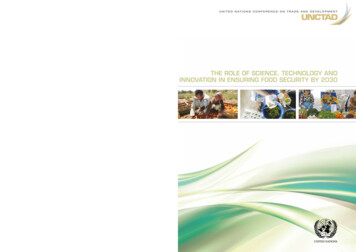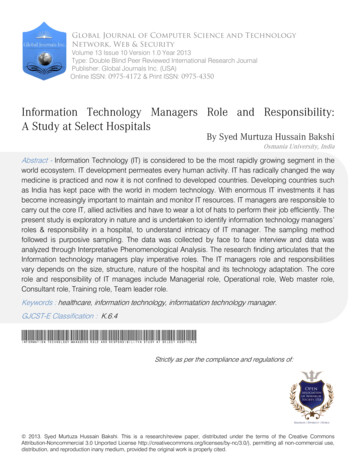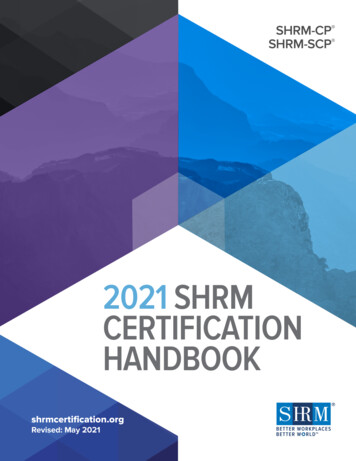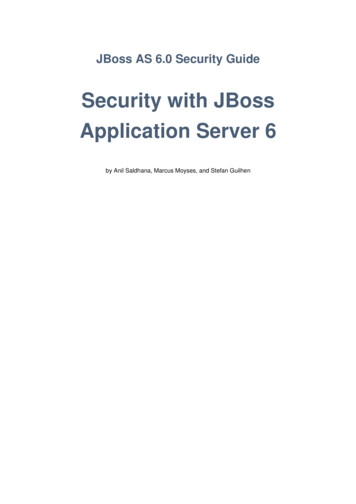
Transcription
U N I T E D N AT I O N S C O N F E R E N C E O N T R A D E A N D D E V E L O P M E N TLayout and Printing at United Nations, Geneva – 1708772 (E) – April 2017 – 636 – UNCTAD/DTL/STICT/2017/5Photo credit: World Bank, Logan Abassi / UN Photo, Stephan Gladieu / World BankTHE ROLE OF SCIENCE, TECHNOLOGY ANDINNOVATION IN ENSURING FOOD SECURITY BY 2030
New York and Geneva, 2017
iiThe role of science, technology and innovation in ensuring food security by 2030NOTEThe United Nations Conference on Trade and Development (UNCTAD) serves as the lead entity within theUnited Nations Secretariat for matters related to science and technology as part of its work on the integratedtreatment of trade and development, investment and finance. The current UNCTAD work programme is basedon the mandates set at quadrennial conferences, as well as on the decisions of the General Assembly of theUnited Nations and the United Nations Economic and Social Council that draw upon the recommendationsof the United Nations Commission on Science and Technology for Development (CSTD), which is servedby the UNCTAD secretariat. The UNCTAD work programme is built on its three pillars of research analysis,consensus-building and technical cooperation, and is carried out through intergovernmental deliberations,research and analysis, technical assistance activities, seminars, workshops and conferences.This series of publications seeks to contribute to exploring current issues in science, technology andinnovation, with particular emphasis on their impact on developing countries.The term “country” as used in this study also refers, as appropriate, to territories or areas. In addition,the designations of country groups are intended solely for statistical or analytical convenience and do notnecessarily express a judgment about the stage of development reached by a particular country or area.Mention of firms, organizations or policies does not imply endorsement by the United Nations.The designations employed and the presentation of the material do not imply the expression of any opinionon the part of the United Nations concerning the legal status of any country, territory, city or area, or ofauthorities or concerning the delimitation of its frontiers or boundaries.Material in this publication may be freely quoted or reprinted, but acknowledgement is requested, togetherwith a copy of the publication containing the quotation or reprint to be sent to the UNCTAD secretariat.This publication has not been formally edited.Reference to dollars ( ) means United States dollars.UNCTAD/DTL/STICT/2017/5Copyright United Nations, 2017
ACKNOWLEDGEMENTSiiiACKNOWLEDGEMENTSUnder the overall direction of Shamika N. Sirimanne, Director of the Division on Technology and Logistics ofUNCTAD, this study was prepared by Bob Bell (UNCTAD); and Ulrich Hoffmann, Bernadette Oehen, AdrianMuller and Lin Bautze (Research Institute of Organic Agriculture).UNCTAD appreciates valuable inputs provided by the Governments of Austria, Brazil, Bulgaria, Canada,Chile, China, Costa Rica, Cuba, the Islamic Republic of Iran, the Netherlands, Nigeria, Pakistan, Peru,Portugal, Sri Lanka, Switzerland, Thailand, Turkey, Uganda, the United Kingdom of Great Britain and NorthernIreland and the United States of America; as well as from the following organizations and agencies: ChineseAcademy of Science Institute of Remote Sensing and Digital Earth, Global Open Data for Agriculture andNutrition (GODAN), International Telecommunication Union (ITU), N2Africa (Wageningen University), UnitedNations Economic, Scientific and Cultural Organization, United Nations Framework Convention on ClimateChange and United Nations Major Group for Children and Youth. Other contributors include Olivia Yambi(International Panel of Experts on Sustainable Food Systems), David Souter (ICT Development Associates)and Elenita (Neth) Daño (ETC Group).Comments and feedback were provided at various stages of preparation by Katalin Bokor, Claudia Contreras,Angel Gonzalez-Sanz, Marta Perez Cuso and Dong Wu (UNCTAD).UNCTAD wishes to acknowledge comments and suggestions provided by Sununtar Setboonsarng (AsianDevelopment Bank) and Nadia Scialabba (FAO). The publication benefited significantly from discussionsand inputs during the Inter-sessional Panel of the CSTD held in January 2017 in Geneva.Nadège Hadjémian designed the cover. Stephanie Kermoal provided administrative support.
ivThe role of science, technology and innovation in ensuring food security by 2030ACRONYMSCFSCommittee on World Food SecurityGHGgreenhouse gasHLPEHigh-level Panel of Experts on Food Security and NutritionICTinformation and communications technologyIFADInternational Fund for Agricultural DevelopmentIPinnovation platformIPESInternational Panel of Experts on Sustainable Food SystemsNGONon-governmental organizationSTIscience, technology and innovationUNCTAD United Nations Conference on Trade and DevelopmentUNDPUnited Nations Development ProgrammeUNESCO United Nations Educational, Scientific and Cultural OrganizationWFPWorld Food ProgrammeWRIWorld Resources Institute
TABLE OF CONTENTSvTABLE OF CONTENTSNOTE .iiACKNOWLEDGEMENTS.iiiINTRODUCTION .viiiChapter 1. The challenge of food security.41.1What is food security?.41.2The geography of food insecurity.41.3The importance of smallholder farmers in food security.41.4What are the challenges of food security?.61.4.1Agriculture, economic development, and international trade.61.4.2Environmental change and agriculture.71.5Millennium Development Goals to halve hunger.71.6Sustainable Development Goals to achieve zero hunger.81.7Conclusion.8Chapter 2. Science and technology for food security.92.1Food availability: Science and technology to improve agricultural productivity.112.1.1Conventional cross-breeding for improved plant varieties and increased crop yields.112.1.2Improving agricultural productivity through transgenic crops.122.1.3Soil management for increasing agricultural yields.132.1.4Irrigation technologies: Technologies that make water available for food production.142.2Food access: Technologies for food accessibility.162.3Food use and utilization: Science for nutrition.182.4Food stability: New ways to combat acute and chronic food insecurity.182.4.1Adapting food production to climate change.192.4.2Using big data and the Internet of things for precision agriculture.192.4.3Early warning systems.202.5Convergence of new and emerging technologies.212.6Conclusion.25Chapter 3. Developing innovative food systems.253.1Promoting a smallholder farmer-focused research agenda.263.2Enabling infrastructure for food systems.283.3Governing agricultural innovation and policy coherence.293.4 Facilitating farmer–scientist knowledge flows: Strengthening agricultural extension andhuman capacity.29
viThe role of science, technology and innovation in ensuring food security by 20303.4.1Participatory cooperative research among farmers and scientists.293.4.2Information and communications technologies for extension services.303.4.3Sharing plant genetic resources.30Making innovative food systems gender-sensitive.31Chapter 4. Policy considerations.314.1Increase investments in agricultural R&D at the global and national levels.314.2Promote sustainable food systems.324.3 Encourage development of science, technology, and innovation applications on key foodsecurity challenges.324.4Support policy coherence for food security.334.5Improve extension services and the farmer–scientist interface.334.6Improve access to agricultural technologies and data for smallholder farmers.344.7Build human capacity for agricultural innovation.344.8 Collaborate with international partners to harness science, technology, and innovation forfood security.344.9Strengthen the enabling environment for agriculture and food security.35.36References .423.5AppendixLIST OF FIGURESFigure 1. Projected number and proportion of undernourished people in developing regions from1990/1992–2014/2016.5Figure 2. Undernourishment trends: Progress made in almost all regions, but at verydifferent rates.8Figure 3. Global water scarcity.15Figure 4. Agricultural losses in sub-Saharan Africa across the value chain for different typesof crops.16Figure 5. Example: Application of the Internet of things, robotics, and artificial intelligence tofarming.23Figure 6. Agricultural innovation system.25LIST OF BOXESBox 1.Bulgaria’s Institute of Plant Physiology and Genetics.12Box 2.Information and communications technologies for improved soil quality in Bangladesh.14Box 3.Purchase for Progress and scaling up nutrition in Guatemala.18Box 4.Big data for sustainable food production in Colombia.19Box 5.Crop Watch: Cloud-based global crop monitoring system.20Box 6.The potential of synthetic biology: CRISPR/Cas9.21
TABLE OF CONTENTS1Box 7.The need for an international technology assessment and foresight mechanism.24Box 8.Bulgaria’s Agricultural Academy.26Box 9.A new CGIAR strategy and results framework for 2016-2030.27Box 10. Employing ICTs to build farmer communities in the United Republic of Tanzania.28Box 11. Improving cotton-farming systems in Western Africa through participatory research.29Box 12. Portuguese information system for plant genetic resources.31LIST OF TABLESTable 1. Examples of science, technology, and innovation for food security.9APPENDIXBox 1The four dimensions of food security.36Box 2Sustainable Development Goals and food security.37Table 1 Relationship between the four dimensions of food security and the SustainableDevelopment Goals .39Table 2 Sustainable Development Goal targets related to Goal 2: End hunger with a relation toscience, technology and innovation.40.41Glossary
2The role of science, technology and innovation in ensuring food security by 2030
Introduction3INTRODUCTIONAbout 795 million people, or every ninth person, is undernourished, with the majority living in developingcountries and rural areas. New, existing, and emerging technologies can address the four dimensionsof food security. For example, genetic modification, methods for improving soil fertility, and irrigationtechnologies can increase food availability. Post-harvest and agro-processing technologies can addressfood accessibility, biofortification can make food more nutritious, and climate-smart solutions anchored inscience, technology and innovation (STI) – including the use of precision agriculture and early warningsystems – can mitigate food instability. New and emerging technologies, including synthetic biology, artificialintelligence and tissue engineering may have potential implications for the future of crop and livestockagriculture. However, harnessing the potential of such technologies for food security requires investmentsin research and development, human capital, infrastructure and knowledge flows. Creating an environmentfor agricultural innovation also benefits from an enabling environment, gender-sensitive approachesto technology development and dissemination, regional and international collaboration, and technologyforesight and assessment for agricultural innovations.The report is divided into four sections. Chapter 1 provides an introduction to the challenge of ensuringfood security, highlighting the geography of food insecurity, specific socioeconomic, environmental andpolitical challenges that exacerbate food insecurity, and the role of the Sustainable Development Goals inensuring “Zero Hunger” by 2030. Chapter 2 discusses how various scientific and technological applicationscan address the four dimensions of food security, namely availability, access, use/utilization and stability.Chapter 3 explores how countries can reimagine their food systems as innovation systems with attention tothe building of local innovative capabilities, enabling infrastructure for agricultural innovation, developingcoherent policies and strengthening knowledge flows to facilitate technology dissemination. Chapter 4presents policy considerations and strategic recommendations for national Governments, the private sector,agricultural research institutions and other stakeholders.
4The role of science, technology and innovation in ensuring food security by 2030CHAPTER 1. THE CHALLENGE OFFOOD SECURITY1.1What is food security?Providing sufficient, safe and nutritious food toall people is one of the major global concernshistorically and in the twenty-first century. Foodsecurity is usually framed in four dimensions foodavailability, access to food, food use/utilization andfood stability (FAO, 2016a).1 These dimensions buildthe overall framework of the definition establishedby the Food and Agriculture Organization of theUnited Nations (FAO): “Food security exists whenall people, at all times, have physical, social andeconomic access to sufficient, safe and nutritiousfood which meets their dietary needs and foodpreferences for an active and healthy life” (FAO,2016b). For each of these dimensions, a seriesof indicators has been defined in order to assessprogress in improving food security (Appendix,Box 1).In addition to the short-term effects of food insecurity,there are also long-term developmental impacts oflack of food security. Beyond the direct obviouscost in terms of lost human lives and well-being,there is an indirect economic cost: Malnourishedpeople are less productive, hungry children get noor little education, and become less capable adultseven if hunger is overcome. Even short-term foodinsecurity has a long-term lasting impact on growthpotential for the economy. This section will explorethe geography of food security, its implications foreconomic development and the environment, andrecent efforts by the international community toachieve “zero hunger”.1.2 The geography of food insecurityAbout 795 million people, or every ninth person,is undernourished, including 90 million childrenunder the age of five (FAO, IFAD and WFP 2015).The vast majority of them (780 million people) live inthe developing regions, notably in Africa and Asia.Depending on the region considered, the shareof undernourished people differs considerably,between less than 5 per cent and up to more thanThose dimensions have been identified by an expertmeeting at FAO that had the task to develop indicators thatallow to measure food security globally (FAO, 2016a).135 per cent (Figure 1). In particular, sub-SaharanAfrica shows high values, with almost 25 per cent ofthe population undernourished (FAO et al., 2015).While the hunger rate - the share of undernourishedin the total population - has fallen in the region, thenumber of undernourished people has increasedby 44 million since 1990 due to population growth.In absolute terms, the number of people exposedto food insecurity is highest in Southern Asia, with281 million undernourished people (FAO et al.,2015).21.3 The importance of smallholderfarmers in food securityAcross all countries, people living in rural areasare the most exposed to food insecurity, owingto limited access to food and financial resources(FAO et al., 2015). Among them, 50 per cent aresmallholder farmers, producing on marginal landsthat are particularly sensitive to the adverse effectsof weather extremes, such as droughts or floods. Anadditional 20 per cent are landless farmers, and 10per cent are pastoralists, fishers and gatherers. Theremaining 20 per cent live in the periphery of urbancentres in developing countries. The demographicsof hunger are tightly coupled with the demographicsof poverty, where approximately 70 per cent ofglobal poverty is represented by the rural poverty ofsmallholder farmers, many of whom are dependenton agriculture. The same applies to hunger andundernourishment that are prevalent in rural areas(HLPE, 2013).Comparing the numbers of the undernourished populationfrom 1990–92 with the projected number for 2014–16, theproportion of undernourished people in the developingregions decreased significantly from 23.3 per cent to 12.9per cent. However, this promising development has to beseen in a different light when accounting for the fact thatthe daily calorific value used as definitional criterion forundernourishment has been significantly reduced in recentyears. If the value had remained unchanged, the figure ofundernourished people would have been well over 1 billion,thus reflecting a reduction in relative terms but not so in absolutenumbers. FAO revised the methodology for calculating thenumber of undernourished in 2011, which led to a decline inthe figures. The new calculation method includes food losses,the assumption that people are less physically active andsomewhat smaller, and that injustice in food distribution is lesspronounced than in the past. With regard to the calculationof figures relating to undernourishment, FAO now assumesa less physically active life style, which is set at 1,840 kcalper day. If FAO had taken a “normal life style” as a basis forthe calculation – some 2,020 kcal per day – the number ofundernourished people would have been 55 per cent higherin 2011–2013 (GLS Treuhand, 2013 and FAO food securitymethodology).2
CHAPTER 1: The challenge of food security5Figure 1. Projected number and proportion of undernourished people in developing regions from1990/1992–2014/2016Source: United Nations, 2015The importance of smallholder farms was backedup by FAO (2015), which states that more than90 per cent of the 570 million farms worldwideare managed by an individual or a family, relyingpredominately on family labour. In Asia and subSaharan Africa, these farms produce more than80 per cent of the food; 84 per cent of familyfarms are smaller than 2 hectares, and familyfarmers manage only 12 per cent of all agriculturalland (FAO, 2015b). Given the structural changetowards large-scale farms in developed countries,where the labour force in agriculture has droppeddrastically over the past decades, the role ofsmallholder farms in developing countries mayhave an ambivalent character. On the one hand,the impact of globalization and market liberalizationis likely to encourage more specialized andlarge-scale industrialized production systems.On the other hand, the environmental, social andeconomic challenges, as well as rapid populationgrowth might require a much more prominentrole of smallholder farming, based on knowledgeand labour-intensive agro-ecological productionmethods that rely on eco-functional intensification.Thus, the role of smallholder farms in food securityremains key, while for a longer-term horizon, theirrole may change depending on structural change.31.4 What are the challenges of foodsecurity?FAO et al. (2015) identified differences in progressnot only among individual countries but also acrossregions and subregions. This section will cover,among other factors, the importance of economicStructural change is desirable; it must involve profoundchanges in agriculture and the transfer of most of its workforceto higher productivity sectors with increasing returns to scale,unlike agriculture. The issue is how to handle the transitionwithout substantially destroying the existing social fabric andin an environmentally acceptable way.3
6The role of science, technology and innovation in ensuring food security by 2030and environmental change in exacerbating theglobal challenge of food insecurity.41.4.1 Agriculture, economic development, andinternational tradeEconomic development is a key success factorin reducing undernourishment, but it has to beinclusive and provide opportunities for improvingthe livelihoods of the poor. FAO et al. (2015) pointout that enhancing the productivity and incomesof smallholder family farmers, investment andsocial protection are key to progress. Smallholderfarmers across the globe are challenged bythe globalization and liberalization of markets,technological advances, and climate change.Previously well-established systems of political,social, economic and environmental resilienceare shifting. Food systems have also undergone arapid transformation in recent years with significantimplications for people’s diets, in part because of anumber of factors such as globalization, expandingfood trade, technological innovations, longer foodsupply and processing chains, and volatile pricesof food commodities. There is also concern aboutincreasing deforestation, as well as the prospectsfor biofuel production to displace land allocated forfood crops.Other factors are directly implicated in the achievementof food security, including increasing population andurbanization, changing consumption patterns, conflicts andparticular topographical features in certain geographies.First, population growth is of main importance, especiallythe increasing concentration in urban regions. By 2050,two thirds of the population is expected to live in cities andshift from agricultural-based economic activities to othereconomic sectors. Unlike the rural population, such urbandwellers will be unable to be at least partly self-sufficientin food production (WFP, 2016). In combination with risingfood prices, unemployment and limited social security, thiscould lead to more people living in urban and suburbanareas who will be exposed to food insecurity (Bazerghi et al.,2016). Second, the human population is expected to becomewealthier and consume more resource-intensive food, suchas animal products (Ranganathan et al., 2016). Third, asillustrated by the food security hotspots identified by the WorldFood Programme (WFP) in September 2016, conflicts are themain drivers for food insecurity in a number of countries (34.5million people). Fourth, even at a country level, food insecuritymight differ between regions. For example, a significantnumber of the world’s population prone to food insecurityresides in mountainous regions. From 2000 to 2012, thenumber of people vulnerable to food insecurity increased inthe mountain areas of developing countries across the world.This means that vulnerability had increased to include nearly329 million people – a number corresponding to 39 per centof the 2012 mountain population (FAO, 2015a).4International trade is required to bring the productionand supply of agri-food products at national levelin line with demand. In addition, it is possible torealize absolute and relative comparative costadvantages through trade. Those may improve thelivelihoods of farmers. Furthermore, trade evensout local production instability, which is expectedto increase in times of weather extremes causedby climate change. However, trade can be a twoedged sword, which can also result in worseningcertain producers’ situations (e.g. in case productsfrom other producers reach the markets with lowercosts). Relevant for international trade rules is theWorld Trade Organization (WTO), and the relatedbilateral, regional and plurilateral liberalizationagreements (outside WTO). Both have an impacton agricultural production, trade and consumption.Agriculture in developing countries now accountsfor slightly less than 10 per cent of GDP. However,if non-market and subsistence production is takeninto consideration, the sector generates half or moreof total gross production and directly or indirectlyemploys 50–80 per cent of the population in manydeveloping countries (UNCTAD, 2015). Togetherwith mining, agriculture is still the most importanteconomic sector, with a high socioeconomicimportance for many countries (for employment,income generation, nutrition, rural developmentand the social fabric). Against this background,primary production, some service sectors, inparticular agriculture, appear to be the only realisticdrivers of economic and social development inmany countries in the nearer future.1.4.2Environmental change and agricultureGrowing demand for food is a key driver ofglobal environment change. FAO statistics showthat maximizing food production by intensifyingproduction has increased the world’s cerealsupply by a factor of almost 2.2, outpacing the1.3 fold increase in population growth in the last50 years (DeFries et al., 2015). However, this 2.2fold increase in global cereal production occurredin tandem with a five-fold increase in the globaluse of fertilizers (UNCTAD, 2013a). Furthermore,biomass production (food, feed, fibre and energy)for developed countries has become a driverfor environmental pressures, competition forland and nutrients in supply regions, whereas
CHAPTER 1: The challenge of food securityoverconsumption and eutrophication of ecosystemsoccur in importing regions.Food production all over the globe is not only asource of global environmental change, but isalso
Angel Gonzalez-Sanz, Marta Perez Cuso and Dong Wu (UNCTAD). UNCTAD wishes to acknowledge comments and suggestions provided by Sununtar Setboonsarng (Asian Development Bank) and Nadia Scialabba (FAO). The publication benefited significantly from discussions and inputs during the Inter-sessional Panel of the CSTD held in January 2017 in Geneva.











